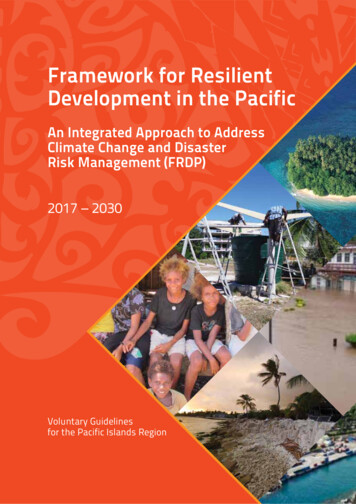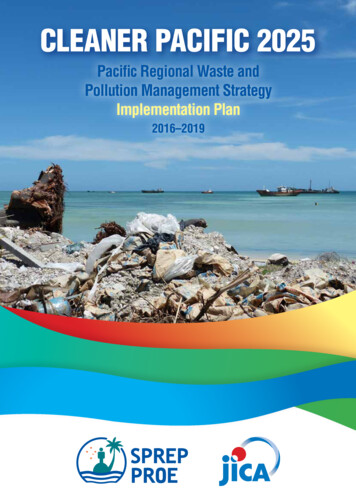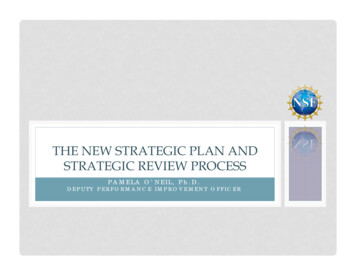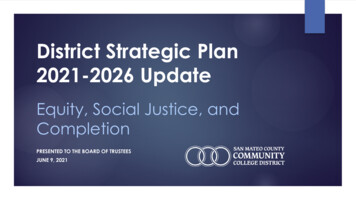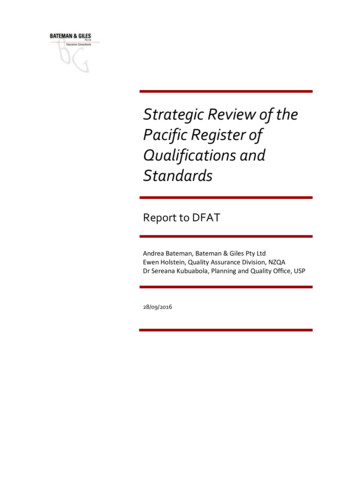
Transcription
Strategic Review of thePacific Register ofQualifications andStandardsReport to DFATAndrea Bateman, Bateman & Giles Pty LtdEwen Holstein, Quality Assurance Division, NZQADr Sereana Kubuabola, Planning and Quality Office, USP28/09/2016
Strategic Review of Pacific Register of Qualifications and StandardsTable of ContentsLists of tables and figures . 4List of acronyms .5Executive summary.71.Background . 131.1 Purpose of review. 131.2 Terminology . 131.3 The PRQS model. 141.4 International and regional context . 152.Findings and analyses.182.1 Governance and remit of the PRQS. 182.2 PRQS model and quality assurance.192.3 Implementation of the PRQS. 212.4 Focus of PRQS activity .252.5 Ownership and engagement of stakeholders . 262.6 Trust and common understanding . 262.7 Mechanisms to support recognition of qualifications . 282.8 Sustainability . 303.Conclusion, recommendations and proposed model . 323.1 Need for a Pacific model that is trusted and valued . 323.2 Proposed model. 333.3 Pre-conditions to the model . 343.4 Support to the model .363.5 Funding and sustainability . 373.6 Recommendations . 38Appendix 1: Terms of Reference .40Page 2 of 81
Strategic Review of Pacific Register of Qualifications and StandardsKey Evaluation Questions (KEQ) . 40Additional Evaluation Questions . 40Recommendations . 41Appendix 2: Methodology . 42Appendix 3: Interviewees. 43Appendix 4: The PRQS model .46Purpose of the PRQS . 46History of the PRQS model . 46PRQS model . 47Funding and staffing of the PRQS . 48Progress to date .50Appendix 5: International context . 53Appendix 6: Regional context . 55Appendix 7: AQRF referencing criteria .64Appendix 8: Future model . 65Appendix 9: Glossary . 77References . 79Page 3 of 81
Strategic Review of Pacific Register of Qualifications and StandardsLists of tables and figuresList of tablesTable 1: Groupings of Pacific countries and territories .25Table 2: PRQS budget . 49Table 3: PRQS qualifications entries . 51Table 4: PRQS qualifications by sector and level . 51Table 5: Current status of countries . 55Table 6: Total outbound internationally mobile tertiary students studying abroad, all countries, bothsexes (number). 57Table 7: Headcount of international students in USP campuses (number) . 58Table 8: Applications for qualifications assessment – Fiji Higher Education Commission . 58Table 9: Applications for qualifications assessment – NZQA Qualifications Recognition Services . 59Table 10: Work and student visas on arrival, New Zealand, 2013 - 2016 . 60Table 11: Timelines and actions . 74List of figuresFigure 1: Allocation of expenditure . 49Figure 2: Proposed Greater Pacific Qualifications Framework . 72Page 4 of 81
Strategic Review of Pacific Register of Qualifications and StandardsList of acronymsAPQNAsia Pacific Quality NetworkAPTCAustralia-Pacific Technical CollegeAQFAustralian Qualifications FrameworkAQRFASEAN Qualifications Reference FrameworkASUAssessment and Standards UnitCARICOMCaribbean CommunityCRGACommittee of Representatives of Governments and AdministrationsCROPCouncil of Regional Organisations in the PacificDFATDepartment of Foreign Affairs and Trade, Australian GovernmentEAS TVET QAFEast Asia Summit Technical and Vocational Education and Training Quality AssuranceFrameworkEQAPEducational Quality and Assessment ProgrammeEQFEuropean Qualifications FrameworkGPQFGreater Pacific Qualifications Framework (‘working title’)INQAAHEInternational Network for Quality Assurance Agencies in Higher EducationNQFNational Qualifications FrameworkNQAFNational Quality Assurance FrameworkNZQANew Zealand Qualifications AuthorityOCTAOffice of the Chief Trade AdvisorPACERPacific Agreement on Closer Economic RelationsPICTAPacific Island Countries Trade AgreementPIFPacific Island ForumPIFSPacific Island Forum SecretariatPQFPacific Qualifications FrameworkPQAFPacific Quality Assurance FrameworkPRQSPacific Register of Qualifications and StandardsRQFRegional Qualifications FrameworkPage 5 of 81
Strategic Review of Pacific Register of Qualifications and StandardsQAQuality assuranceSPBEASecretariat of the Pacific Board of Educational AssessmentSPCSecretariat of the Pacific CommunityUSPUniversity of the South PacificTVETTechnical Vocational Education and TrainingPage 6 of 81
Strategic Review of Pacific Register of Qualifications and StandardsExecutive summaryThe Australian Department of Foreign Affairs and Trade (DFAT) commissioned a strategic review of thePacific Register of Qualifications and Standards (PRQS) to: Identify lessons learned from the PRQS’s efforts to facilitate the benchmarking of Pacificqualifications against international standards and to facilitate Pacific learner and labour mobility Recommend to DFAT a future model of support that will promote greater institutional andprogram compliance with quality standards, foster international recognition of qualifications, andfacilitate Pacific learner and labour mobility.The PRQS program became operational in February 2009. Australia has funded the PRQS from itsinception and to the end of December 2016. Funding allocation over this period has been AUD 3,058,399,with staffing salaries and benefits (74%), and workshops/meetings and consultancy fees (21%) being thetwo largest costs. A small team, the Accreditation and Standards Unit (ASU), based within theEducational Quality and Assessment Programme (EQAP), leads the PRQS.The PRQS model is both complex and multi-faceted and links a regional qualifications framework and aregional quality assurance framework to that of a register of recognised agencies, approved qualificationsand providers. The PRQS aimed to: Support the mobility of Pacific learners and labour, and foster and sustain regional integration Facilitate informed decisions and choices about comparable and recognised qualifications,accrediting agencies, education and training institutions, professional status of workers, andregional occupational standards in the Pacific region.1To what extent the PRQS program has facilitated the benchmarking of Pacific qualifications againstinternational standards, and Pacific learner and labour mobility into further educational opportunities orentry into the global labour market, is a critical aspect of the review.The PRQS relies on other competent bodies (i.e. national quality assurance [QA] agencies), regionalprofessional associations or other regional initiatives to be able to populate the register. The current PRQSprogress reflects the member countries’ progress of establishing National Qualifications Frameworks(NQFs), quality assurance and governance arrangements. The progress to date includes the PRQSrecognising and listing six national agencies, one regional agency for USA aligned education systems, twosectoral agencies,2 124 quality-assured qualifications, and three regional benchmarks. There have been noitems listed in the professional licensing and occupational standards or the traditional knowledge andindigenous skills domains.It is considered that the current quality assurance arrangements of the PRQS have not engendered trust orhigh accountability of its members, possibly due to the lack of rigour of quality review of agencies andeffective self-assessment activities. In addition, the lack of benchmarking or harmonisation of agencyprocesses has meant that there have been very few gains in recognising agency decisions in terms ofaccreditation of qualifications and registration of providers across borders. In addition, the inclusion ofsectoral agencies poses a level of risk that has not yet been realised. Other strategies to promoteharmonisation of processes (e.g. implementing a regional model for a Diploma Supplement, anddeveloping regional occupational standards) are only emerging.The duplication of qualifications on the register has not prompted benchmarking activities, and the lack oftransparency of qualification details on the database does not enable any benchmarking or comparisons1SPC 2015a, p. 6.Theological education: South Pacific Association of Theological Schools, and Maritime Training: SPC’s TransportProgramme (Economic Development Division).2Page 7 of 81
Strategic Review of Pacific Register of Qualifications and Standardsby countries of these qualifications. The register only includes qualifications, and does not enable shortcourse or skills sets that could be recognised, which would further the flexibility of the register.The lack of ownership and engagement of key stakeholders of the PRQS and its profile across the region isconcerning. The governance arrangements of the relevant boards or committees has not promotedengagement across the membership of the PRQS or extended opportunities to the broader Pacificcountries and territories. The lack of visibility of the PRQS beyond that of national agencies is concerning.The top down approach to quality assurance is potentially alienating to the member countries and placesthe locus of control with EQAP rather than with the broader Pacific community. Finally, the review teamquestioned EQAP’s remit to be able to accredit qualifications and register providers across borders, giventhe national context of legal obligations.However, within the context of increasing globalisation, the international development of regionalqualifications and quality assurance frameworks, means that there is still a need, or even a greater need,for a Pacific model. The PRQS, as a key regional initiative, can provide a forum for any regionalconsultations in relation to qualifications and quality assurance; foster common understanding and trust;and, develop national capacities in terms of recognition of qualifications.Within the region a recent driver for enhanced labour mobility, the Pacific Agreement on Closer EconomicRelations (PACER) Plus, has increased the focus on skilled occupation mobility and how the PRQS couldsupport the movement of learner and labour mobility. The implications of the PACER Plus agreement onthe future role of the PRQS are significant. The PRQS also has the potential to support other regionalinitiatives, such as Revised Asia-Pacific Regional Convention on the Recognition of Qualifications in HigherEducation 2011, which provides general guidelines intended to facilitate the implementation of regionalcooperation regarding recognition of qualifications in the higher education/TVET sector.If learner and labour mobility is of critical importance to the region, then recognition of qualifications andskills is a key strategy to facilitate this mobility. The Pacific model, being a regional initiative, could be akey catalyst for change and be paramount in supporting recognition and in turn facilitating learner andlabour mobility. The PRQS has developed out of an educational context, which is similar to other regionalqualifications frameworks. However, as the push for greater connectivity with labour and trade priorities(e.g. trade agreements, labour mobility) increases, it is natural that additional stakeholder groups need tobe engaged.Given the current context, it is timely to review the current PRQS model and propose an enhanced modelto provide a clear focus and purpose and to provide stability and sustainability over the longer term.The details of a proposed future Pacific model are included in Appendix 8.A future Pacific model needs to focus on building trust across the broader Pacific region, on harmonising3recognition processes, and to take a proactive role in developing regional mechanisms to supportrecognition, for example, regional occupational standards and qualifications.To foster a high level of trust and accountability by its members the following should be undertaken: A robust referencing, that includes engagement by relevant stakeholders, of NQFs and NQAFs tothe PQF and PQAF, which is fit-for-purpose, given the size and scope of the qualifications systems Development of clear and unambiguous agreed quality assurance processes, including robustself-assessment by competent bodies for entry onto the register, strengthening internalself-review and evaluation of competent bodies, and requiring external quality evaluations on aperiodic basis A focus on supporting mutual recognition of competent body decisions through harmonisingprocesses of accreditation of qualifications, registration of providers, through benchmarkingqualifications and recognition of foreign qualifications.3Harmonisation is about bringing into agreement (or harmony) of related quality assurance processes. It does notnecessarily mean all processes are the same.Page 8 of 81
Strategic Review of Pacific Register of Qualifications and StandardsAny future Pacific model should promote the quality of qualifications, through a focus on the developmentof regional qualifications (occupational and assessment standards, qualification completion rules, PQFlevel) or co-opting national qualifications for regional qualifications so to facilitate benchmarking andrecognition of occupations and skills across the Pacific and beyond. Shifting the focus makes the Pacificmodel less reliant on national progress of agencies.The future Pacific model should also continue to strengthen its relationship with other RegionalQualifications Frameworks, and with national qualifications frameworks of key receiving countries (e.g.Australia and New Zealand).If the Pacific model is to be maintained and strengthened, it needs to have ownership by the Pacific IslandForum (PIF) countries and territories, have clear and identifiable benefits to them and be incorporated intoother regional and international initiatives and agreements. Without these, the Pacific model will surelyfalter. To strengthen the engagement and ownership of a future Pacific model the model’s governancearrangements should include: The establishment of a governing committee that includes all PIF countries with equal votingstatus, with an intent to engage other countries in the greater Pacific region and that distancesdonors from the management and operations of the initiative Acceptance and confirmation of a revised Pacific model by PIF education ministers, tradeministers and economic ministers, and reporting to the three sets of ministers.Other strategies to strengthen the use of the future Pacific model (especially the PQF) could be through: Promoting the inclusion of the Pacific model in bilateral or multilateral agreements related tooccupations or occupational standards Benchmarking of qualification activities regionally and/or internationally Having strategies for badging and promoting the revised Pacific model to raise its profile beyondit members, across the Pacific and internationally Increasing transparency of information provided on the register to enable benchmarking ofqualifications Linking this regional initiative to national bilateral programs, for example, incentivise the uptakeand provision of regional occupational standards (and qualifications) at a national level.However, the progress of the PRQS is linked to each Pacific Nation’s progress with quality assuringqualifications. The following pre-conditions are crucial to the success of the future Pacific model. PacificNations need to have: The legal remit to quality assure TVET and Higher Education sectors The associated processes to undertake the key functions (accreditation of qualifications andregistration [approval and monitoring] of providers, e.g. documented in regulations, policies andprocedures as well as, costing schedules, complaints and appeals processes Personnel to manage the key functions and make accreditation and registration decisions 4 The capacity to outsource technical services through a third party to undertake the work The capacity to undertake rigorous internal quality assurance and review of its own processes.These pre-conditions are relevant to all Pacific Nations with emerging QA processes, and is especiallyrelevant where work is underway in current bilateral development programs and where the legal remit andthe competent QA body capacity are not evident.4This is often through a competent QA body enshrined in legislation, but may be a small unit of 1–2 people within agovernment department.Page 9 of 81
Strategic Review of Pacific Register of Qualifications and StandardsPacific Nations also need to have in place individual providers that have the capacity to deliver qualityeducation and training (e.g. access to curriculum, equipment, facilities, qualified trainers and assessors,and management systems), and to undertake robust internal quality assurance and review processes.Support for these pre-conditions could take a range of forms, such as a focus on bilateral supportprograms to ensure the legal framework, structures and processes are in place for quality assuringeducation and training; or using regional initiatives, such as APTC and USP to provide support to bothTVET and Higher Education sectors in terms of provider capacity. Other Pacific QA bodies could alsoprovide assistance to emerging QA bodies.Once the future model is agreed then the number of secretariat staff can be determined; however, thelikelihood would be no more than two staff members. The secretariat staff will need a strongunderstanding of qualifications frameworks, regional frameworks, quality assurance and recognition. Amodel of support for the secretariat should include a technical advisory group. The technical advisorygroup could provide mentoring support, strategic advice, and specialist services to assist in developing keydocuments, operationalising benchmarking and referencing activities and assist in workshops andmeetings, including information technology support to assist in the enhancement of the register.Funding to the future Pacific model is required for the next 3–5 years. Any proposal for funding the futurePacific model is predicated on the aim that the model is self-funding after 8 years, through Pacific Nationfinancial contributions and any fee for service activity. In the immediate future, Australia DFAT could seekadditional donor partners for the support of the future Pacific model. For Australia, the most logical choicefor a donor partner is New Zealand.Transitioning to a new model will require a concentrated input over the next 3–5 years. Initially, effortsshould focus on confirming a revised model design with the Pacific Nations and on the establishment ofgoverning arrangements. Once established, the focus should be on increasing the portability ofqualifications and occupations through the development of agreed regional qualifications, andbenchmarking of existing national qualifications to these regional qualifications. In addition, promotinginternal and external review of the competent QA bodies by recognised agencies and/or experiencedpersonnel, and promoting harmonisation processes (including referencing NQFs and benchmarkingquality assurance processes) should assist in enhancing trust and common understanding.The review concluded that there is still a need, or even a greater need, for a future Pacific model and thatthe full potential of the current PRQS has not been realised. It is timely to review and shift the focus of thePRQS and provide some stability and clear direction for the next 3–5 years.It is recommended that DFAT:1. Commit to funding a future Pacific model for the next 3–5 years, and to seeking support from NewZealand as a donor partner2. Confirm with the Pacific Nations a revised model that includes:a. Development of regional qualifications (occupational standards, assessment standards,and qualification completion rules, PQF level) to facilitate benchmarking and recognitionof qualifications, occupations and skills across the Pacific and beyond5b. Fostering a high level of trust and accountability by its members by referencing NQFs andNQAFs to the PQF and PQAF, and which is fit-for-purpose, given the size and scope ofthe qualifications systems and appropriate level of engagement by relevant stakeholders5Countries can either utilise these regional qualifications and supplement for national accreditation purposes or benchmarktheir existing qualifications to these regional qualifications. A simple way to promote the recognition of these qualificationsis to ensure that the PRQS website includes in detail the occupational and assessment standards, and the qualificationcompletion rules. In addition, certificates issued at a national level could include details of the qualification’s relationship tothe regional qualification.Page 10 of 81
Strategic Review of Pacific Register of Qualifications and Standardsc.Fostering a high level of trust and accountability by its members to be facilitated by clearand unambiguous agreed quality assurance processes, including:i. A robust self-assessment process for competent QA body recognition for entryonto the registerii. Strengthening internal self-review and evaluation of competent QA bodies andrequiring external quality evaluations on a periodic basis.d. Supporting mutual recognition of competent QA body decisions through:i. Harmonising processes in regards to accreditation of qualifications, registrationof providers and approval to deliver processes across countriesii. Harmonising benchmarking and recognition of qualification processes.e. Having strategies for badging and promotion of the revised Pacific model to strengthenits profile across the Pacific and internationally, beyond the key stakeholders. This mayinclude (but is not limited to) using a Diploma Supplement model and/or logo onqualifications based on regional occupational standards.3. Work with participating Pacific Nations to confirm revised governance arrangements:a. Whereby a governing committee is established, with all PIF countries and territoriesmembers having equal voting status, to foster ownership and engagement6b. With an intent to engage other countries in the greater Pacific region by encouragingobserver statusc.That distances donors from the management and operations of the initiatived. That are supported by a small secretariat to provide strategic focus and operationalassistance.4. Ensure that the future Pacific model:a. Is documented in a briefing paper that outlines the scope, purpose and structure of themodel, as well as competent body obligations, governing committee roles and functions,and secretariat roles and functionsb. Is designed and agreed by PIF countries and territories’ competent QA bodyrepresentatives as members of the governing committeec.Has a 3-, 5- and 8-year plan with final transition from a donor-funded program to beingsupported by the broader Pacific region and supplemented by fee for service activitiesd. Is accepted and confirmed by PIF education ministers, trade ministers and economicministers, with the governance arrangements requiring reporting to the three sets ofministers.5. Confirm funding for a technical advisory team to assist in fine tuning the design and providingsupport and advice to the Secretariat and governing committee over the longer term6. Strengthen the use of the future Pacific model (especially the PQF and PQAF) through inclusion inbilateral or multilateral agreements related to occupations or occupational standards (e.g. mutualrecognition agreements) or in benchmarking of qualification activities (either regionally orinternationally).In addition, DFAT should promote associated pre-conditions required within Pacific Nations, by:6Australia and New Zealand representatives have not been considered members of the PRQS. They will need to make theirposition clear in terms of whether they are members of the future model, or non-voting members, or observers.Page 11 of 81
Strategic Review of Pacific Register of Qualifications and Standards7.Working with Australia Posts in the Pacific and bilateral programs to establish the pre-conditions,such as ensuring country competent QA bodies have the legal remit to quality assurepost-secondary sector, have the capacity to implement processes and manage the key functionsand to undertake rigorous internal quality assurance and review of their own processes8. Working with APTC to support key or strategic providers to improve their capacity to deliverquality training and assessment, and meet external quality standards9. Considering funding to USP to assist higher education institutions in Pacific Nations to improveinternal quality assurance and curriculum accreditation arrangements10. Working with bilateral programs to coordinate and rationalise the development of nationalqualifications to avoid duplication, promote sharing and using the protocol
The PRQS model is both complex and multi-faceted and links a regional qualifications framework and a regional quality assurance framework to that of a register of recognised agencies, approved qualifications





